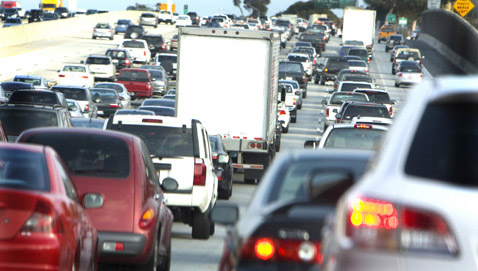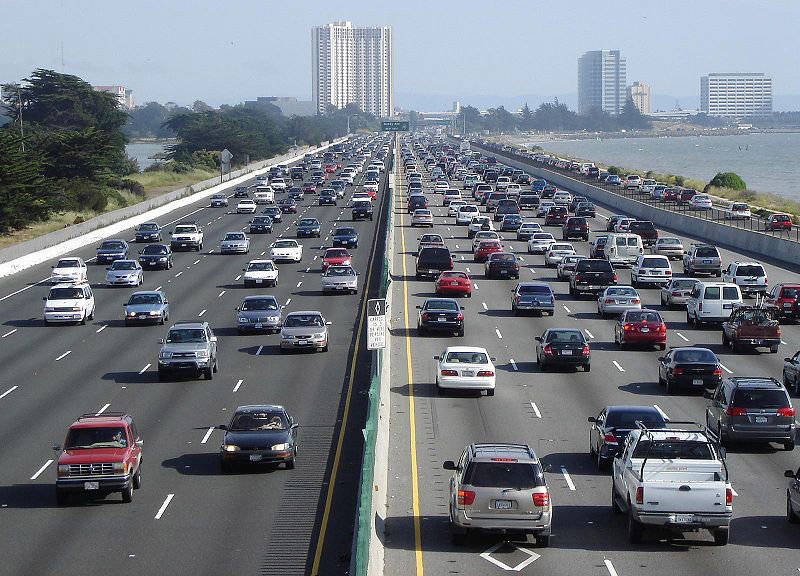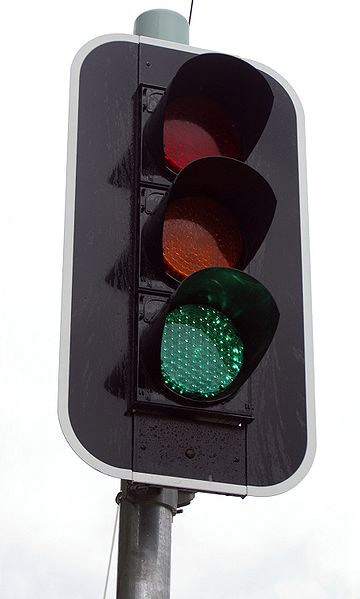Lesson: Better Traffic Flow
(Provided courtesy of the the Mathematics, Science and Technology Education (MSTE) program at the University of Illinois at Urbana-Champaign. Authors: E. Joseph Kocinski and Edsel Clark III)

California traffic jam
Frustrated by gridlock? Traffic engineers feel your pain. Using math, they devise ways to improve the flow of vehicles at busy intersections and on highways. Here is an example of the kind of problem they might try to solve. Designed for advanced high-school algebra students, it can be worked out most easily using Microsoft Excel. Explore traffic engineering further with a competition developed at the University of Toronto, an animated diagram, and a game called Gridlock Buster.
1. Statement of Problem
Find the maximum number of cars passing a point in a given amount of time. This number (x) changes with a differing velocity (v) and is dependent upon the length of a car (l) and the distance between cars (d). For simplicity’s sake, an average l is set at 5m and the set time is 60 seconds.
2. Connection to National Standards
This activity incorporates two algebra topics that the National Council of Teachers of Mathematics has designated to receive increased attention in grades 9-12. First, the traffic problem is a real-world problem that requires the application of theory.
Second, by solving this problem on Microsoft Excel, the activity uses computer utilities to develop a conceptual understanding of the information at hand.
3. Description of Approach to the Problem
As a means of attacking the problem, it was decided that a given distance would be comprised of (x cars)*(l) + (x-1 spaces between cars)*(d). However, Professor Hans-Georg Weigand advised us that a sufficient equation is (x cars)*(l + d). Still regarding this as a distance, we inserted it into the equation velocity = distance*time. Then, solving for x, we obtained the equation x = v*t/(l+d). After substituting constant values for t and l, we obtained x = v*60/(5+d). All that remained to be done was to evaluate for x with respect to 3 condition of d: 1) d is constant; 2) d is proportional to v; 3) d is proportional to v^2. However, as it turns out, a constant must be solved for when working with the third condition. This value was obtained by performing a simple calculation on data found in Road & Track magazine.
4. Description of Appropriateness for Secondary Level Audience
This traffic problem is most suitable for an advanced algebra or college algebra class. The students should work in groups of four to solve the problem. When it comes to finding the stopping distance related to the velocity squared, not only could students gather data from a magazine, they could measure the stopping distance of a car in a parking lot.
5. Findings
There were several important findings in this activity. First, we learned that our value of d cannot be constant or proportional to v because the result is that the greater the velocity, the greater number of cars. We know that this result is unrealistic because having 5m or even 40m between cars travelling at 40m/s is extremely dangerous and thus not a feasible result. Also, we learned that having distance proportional to velocity squared is an accurate situation, provided that a constant is included to account for the realistic stopping distance of a car. From this fact, our equation demonstrated that the maximum number of cars pass the point at 12m/s.
6. Effects of using Excel
Excel proved to be extremely beneficial in efficiently solving this traffic problem. For one, it made hundreds of calculations faster than any human or calculator could have done. Excel makes it easy to see what happens for different values of car length, velocity, or any other variables. Having all the data in the spreadsheet form makes it easy to understand and convenient to display the results graphically.

Statement of Problem:
There is a traffic jam at the highway when cars have to pass a building site. A line of cars is passing the building site. We do a model of this situation. All cars drive with the same speed v and they all have the same length l. For the distance d between two cars there are some possibilities:
1. d is constant (is it a good situation?)
2. d depends on the speed: d proportional to v (why not?)
3. d depends on the speed: d proportional to v^2 (why?)
* At what velocity will the maximum number of car pass the building site?
In order to solve the problem we set l = 5m and t = 60 seconds.
We let x = the number of cars.
Thus, the equation necessary to solve the problem is:
x = v * 60
________
5 + d
Continue working the problem using Excel.
Supplemental Activities
Keep The Traffic Moving!
Welcome to a competition that was held in 1996 by the UNIVERSITY OF TORONTO MATHEMATICS NETWORK. Although that competition is over, you are still invited to try your hand at exploring mathematics in action in this real life situation! Thanks to original developer Philip Spencer.
The scenario
Everybody knows how frustrating it is to sit at a red light. Worse than that, a light which is red too long can cause cars to back up endlessly, leading to gridlock and other chaos. It is the job of the traffic engineer to time things so that the traffic has the least amount of waiting to do.
In this competition, you are the traffic engineer. You control the timings of the lights at the six intersections shown in the picture below. Each road has two lanes, one in each direction. The lanes are each 4 metres wide (so each road is 8 metres wide), and the spacing between the roads is as shown. For convenience we’ve numbered the lanes from 1 to 10, indicated their directions, and labelled the lights A through F.
You can control these lights yourself through this computer simulation.

What You (the Traffic Engineer) Already Know
You have measured the traffic densities d[1], . . . , d[10]: the number of cars per minute trying to use each lane.
You have also found that the traffic behaviour (the way a car speeds up or slows down when faced with an obstacle in front, such as a red light or another car) follows a certain mathematical model governed by three numbers c, l, and L (the model is described in the section Details on the Mathematical Model Used).
What You Need to Figure Out
This competition has three parts; we encourage you to test your mathematical skills on any or all of them! Parts I and II require you to do some serious mathematical thinking, but in Part III all you have to do is time the lights and see if you can beat the current “high scores” on the computer. So, if you’re not in a serious mathematical mood right now, you can skip to part III.
To get the full details on each part you can use the “I”, “II”, “III” icons at the top and bottom of each page. Here’s a brief description of them:
How can you use the information you have (the thirteen numbers d[1], . . . , d[10], c, l, and L) to decide whether traffic lights are even feasible, or whether a more drastic solution is required, such as widening the roads or building overpasses?
In the detailed discussion of this part, we’ll give you hints on how basic algebra can be used to come up with a simple set of inequalities that tells whether or not traffic lights would be capable of handling the traffic flow. See if you can figure out this formula. You can test your answer on the computer simulation.
What happens when a long light of cars is waiting at a red light, and the line turns green? If you’ve ever been near the back of such a line, you’ve probably sat in frustration wishing the cars in front would get a move on! But is it only their slowness in reaction?
In the detailed discussion of this part, we’ll explain how ideas of calculus and ” differential equations” can be used to answer the question, and challenge you to find out how long it takes for the line to get moving even if everybody’s reaction time is instantaneous and there’s no limit on the cars’ acceleration power. You may be surprised at the answer, and less inclined to blame the cars in front of you next time you’re kept waiting! Note: the mathematics in this part is quite challenging and requires a knowledge of calculus. But you can still watch what happens on the computer simulation even if you can’t solve the problem mathematically.
Find the best light timings for three specific situations. In the detailed discussion of this part, we give you three different situations (three different sets of numbers for d[1], . . . , d[10], c, l, and L). Your job: time the traffic lights in a way that causes the least amount of delay. This part of the competition is a free-for-all: you can use any combination of mathematical reasoning or pure experimentation. The computer simulation lets you enter timing values, watch what happens, and get a score for how well your timings did. It keeps track of the high score, so see if you can beat it and get a new high score!
Good luck!
[This gridlock animation, on The Nature of Urban Traffic Gridlock, from the Center for Future Urban Transport at the University of California-Berkeley, no longer works. See instead Scientific American’s YouTube on how traffic jams occur.]
Finally, have your class play Gridlock Buster.
 This is an online traffic control game based on tools and ideas that actual traffic control engineers use in their everyday work. It’s from the website of the University of Minnesota’s Center for Transportation Studies. Also check out the site’s K-12 transportation engineering lessons and activities.
This is an online traffic control game based on tools and ideas that actual traffic control engineers use in their everyday work. It’s from the website of the University of Minnesota’s Center for Transportation Studies. Also check out the site’s K-12 transportation engineering lessons and activities.
Filed under: Grades 9-12, Lesson Plans
Tags: Research on Learning








